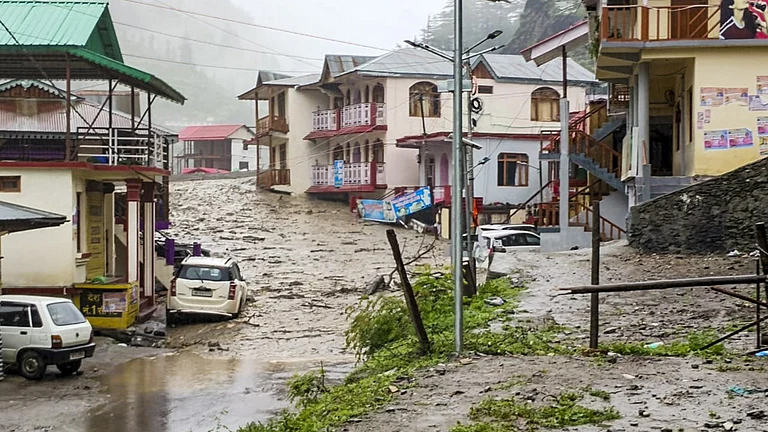
Recurring Disasters: The Himalayas have witnessed repeated floods, cloudbursts, earthquakes, and glacial lake bursts, signalling a systemic crisis rather than isolated accidents
Ecological Degradation: Massive deforestation, hydropower tunnelling, unsafe road expansion, and unchecked construction have stripped natural safeguards like forests and floodplains
Ignored Warnings: Despite official advisories and eco-sensitive zone notifications, enforcement has been weak. Projects continued despite clear evidence of ecological harm
Tourism & Hydropower Pressure: Unregulated tourism and stacked hydropower projects have prioritised short-term gains over environmental safety, often worsening the scale of disasters
Climate Change as Accelerant: Intensifying rainfall, retreating glaciers, and swelling glacial lakes have amplified hazards, making disasters more frequent and costly
Kedarnath, June 2013. A cloudburst and glacial lake outburst sent torrents crashing through the Mandakini valley, drowning the holy town of Kedarnath and killing more than six thousand people. Roads, bridges and entire settlements vanished in hours. It was the first unmistakable warning that the Himalayas could no longer absorb the abuses piled upon them.
Uttarkashi, 5 August 2025. In Dharali, pilgrims paused when a low rumble echoed through the valley. Minutes later a wall of water, boulders and timber tore through the village, sweeping away more than a hundred riverside buildings. At least four died, dozens were missing, and a hotelier watched his forty-room lodge dissolve into the torrent.
Nepal Eartquake, April 2015, the devastating temblor unleashed a cascade of landslides across the Himalayan arc. Villages perched on fragile slopes collapsed, valleys were cut off for weeks, and thousands perished under rubble and falling rock.
Kishtwar, Jammu and Kashmir, 14 August 2025. In Chasoti, a two-storey wooden home crumbled in seconds as a cloudburst unleashed a torrent of mud and rock. “It was as if the mountain was coming down,” said survivor Piyra Singh. By the time silence returned, sixty were dead, more than 160 injured and dozens unaccounted for.
The Pattern of Disaster
It is tempting to read each of these tragedies as isolated accidents, localised failures, or cruel acts of nature. Yet place them side by side with Chamoli in 2021 and the South Lhonak lake burst in Sikkim in 2023, and the pattern becomes undeniable. These are not accidents but sequels in a long and terrible saga. They are the Himalayan story of our times: a fragile mountain system stripped of its protections, battered by reckless human intervention, and hammered by a changing climate. The disasters now come not once in a generation but every few years, each one more deadly, each one more costly.
The Himalayas are among the youngest mountain systems in the world, still rising five millimetres a year. Their slopes are geologically unstable, their rivers swift and unpredictable. For centuries, their resilience came from their forests, the deep-rooted cover that anchored soil, absorbed rain, and recharged springs. Floodplains spread out the monsoon’s violence, sediment fans dissipated energy, and meanders slowed the river’s fury. Over the past five decades, that natural shield has been stripped away.
Satellite data show Uttarakhand alone lost over twenty-two thousand hectares of tree cover since 2001, much of it on slopes that were already fragile. Where forests once spread like sponges across hillsides, concrete hotels and hydropower tunnels now multiply. Along the Bhagirathi and Alaknanda rivers, official assessments warned that more than eighty per cent of the valley length was already severely affected by hydropower projects. The Wildlife Institute of India advised cancelling at least twenty-four projects because of irreversible ecological damage. The advice was noted and ignored.
The Char Dham highway expansion offers another stark example. Designed to widen roads for pilgrims and military convoys, it cut steep slopes at unsafe angles. A peer-reviewed study mapped more than eight hundred landslides across the 800 kilometres of corridors and found eighty per cent of them linked to recent slope-cutting near the road. The Supreme Court’s compromise, allowing ten-metre-wide paved shoulders, prioritised strategic mobility but left the hillsides bleeding rock and soil. In 2023, the Silkyara tunnel collapsed, trapping forty-one workers for weeks, underlining the price of ignoring the Himalayan geology.
Development that Courts Destruction
The failures do not bespeak ignorance but weak and even corrupt enforcement. After Kedarnath, the Bhagirathi Eco-Sensitive Zone was notified to restrict hazardous activity across more than four thousand square kilometres. Yet hotels sprouted right on the riverbank in Maneri and Jamak, their foundations encased in concrete embankments that narrowed channels and forced rivers to gather lethal speed. Residents and independent monitors flagged the violations repeatedly, but local officials and state authorities looked away. Environmental impact assessments have been diluted, exemptions multiplied, and penalties kept too small to deter. Corruption and political patronage greased the way.
At Dharali, the hotel strip that the river erased was not an accident of topography. It was a business model. The Himalayas have been turned into prime real estate for tourism, with little regard for carrying capacity. Uttarakhand recorded more than forty-five million visitors in 2022, and the number of registered hotels in Uttarkashi doubled in a decade. Unregistered establishments multiplied even faster. A river-view room fetched more money than an upland farm ever could, and that incentive overrode both environmental caution and common sense. The river became a backdrop for selfies, until it rose as a force of erasure.
Hydropower is the other pillar of this fragile economy. Touted as clean energy, it has tunnelled through mountains and blasted riverbeds, destabilising slopes and dumping debris into valleys. Multiple projects are often stacked within a few kilometres, compounding the stress. When the Chamoli glacier burst in 2021, it was not only villagers and workers who died but entire powerhouses and bridges worth hundreds of crores. In Sikkim, the Teesta III dam was obliterated in minutes when the South Lhonak lake burst. The promise of green energy dissolved into twisted steel and drowned investment.
Staggering Costs
Climate change is the accelerant. Warmer air holds more moisture, and when it rises over steep terrain, it unleashes sudden, violent downpours. The Indian Meteorological Department has tracked a more than fifty per cent increase in “very heavy” rainfall events in the central Himalayas over the past two decades. Glaciers are retreating, lakes are swelling, and their sudden bursts add to the chain of destruction. The Hindu Kush Himalaya holds over two thousand glacial lakes, more than two hundred classified as dangerous. Each is a potential time bomb waiting for the right mix of heat and rain.
The costs are staggering. The World Bank estimated losses of 3.8 billion dollars from the Kedarnath floods. Chamoli’s toll ran into hundreds of lives and billions in destroyed assets. The South Lhonak burst shredded bridges and dams, with costs still being tallied. Insurance coverage is scarce, premiums will only rise, and banks will discover that hotels and homes built on riverbanks are poor collateral. The poorest families, who have no insurance at all, lose not only their homes but their futures.
For survivors like Piyra Singh in Kishtwar, the reckoning is immediate. “Our homes are gone, our employment is gone, my uncle and cousin are dead,” he said. He had thought he would continue studying, but now he is burdened with responsibilities. “I don’t know if we will live in this village now.” For him and for many others, disaster is not an abstraction or a satellite image. It is the absence of a roof, the silence of a brother, the burden of a future suddenly thrust upon them.
Prevention Is the Only Insurance
Yet even as families mourn, the cycle of neglect resumes. After Kedarnath, committees promised stricter rules. After Chamoli, warnings about glacial lakes made headlines. After Sikkim, hydropower projects were briefly reassessed. Each time, the outrage ebbed, projects restarted, and the old habits returned. The Himalayas are treated as an inexhaustible asset, a backdrop to tourism campaigns and religious journeys, rather than a fragile system that holds the lives of millions in delicate balance.
The lesson of these disasters is that prevention is not optional. The natural defences of the Himalayas cannot be endlessly dismantled without consequence. Every hectare of forest felled, every metre of floodplain encroached upon, narrows the margin of survival. Early warning systems, stricter enforcement of eco-sensitive zones, and serious caps on tourist inflows are not radical ideas but basic insurance against catastrophe. Communities should be compensated to keep forests standing, rather than lured to cut them down. Rivers should be allowed to meander and spread, rather than forced into concrete channels that accelerate their violence.
The Himalayas are not an endless frontier to be mined and marketed. They are the water towers of South Asia, feeding rivers that sustain hundreds of millions downstream. Their forests regulate rainfall, their soils anchor slopes, their glaciers hold the future of water security. To treat them as disposable is to gamble with the very foundations of life in the subcontinent.
The roar in Kishtwar, the torrent in Dharali, the mudslides in Buner are warnings. The next cloudburst will come, the next glacier will melt, the next slope will collapse. The only question is how many more lives we will lose before we stop pretending to be surprised.


































